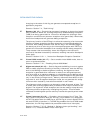
Vol. 3 2-11
SYSTEM ARCHITECTURE OVERVIEW
running program or task. SMM-specific code may then be executed transparently.
Upon returning from SMM, the processor is placed back into its state prior to the
SMI.
• Virtual-8086 mode — In protected mode, the processor supports a quasi-
operating mode known as virtual-8086 mode. This mode allows the processor
execute 8086 software in a protected, multitasking environment.
Intel 64 architecture supports all operating modes of IA-32 architecture and IA-32e
modes:
• IA-32e mode — In IA-32e mode, the processor supports two sub-modes:
compatibility mode and 64-bit mode. 64-bit mode provides 64-bit linear
addressing and support for physical address space larger than 64 GBytes.
Compatibility mode allows most legacy protected-mode applications to run
unchanged.
Figure 2-3 shows how the processor moves between operating modes.
The processor is placed in real-address mode following power-up or a reset. The PE
flag in control register CR0 then controls whether the processor is operating in real-
address or protected mode. See also:
Section 9.9, “Mode Switching.” and Section
4.1.2, “Paging-Mode Enabling.”
Figure 2-3. Transitions Among the Processor’s Operating Modes
Real-Address
Protected Mode
Virtual-8086
Mode
System
Management
Mode
PE=1
Reset or
VM=1VM=0
PE=0
Reset
or
RSM
SMI#
RSM
SMI#
RSM
SMI#
Reset
Mode
IA-32e
Mode
RSM
SMI#
LME=1, CR0.PG=1*
See**
* See Section 9.8.5
** See Section 9.8.5.4


















